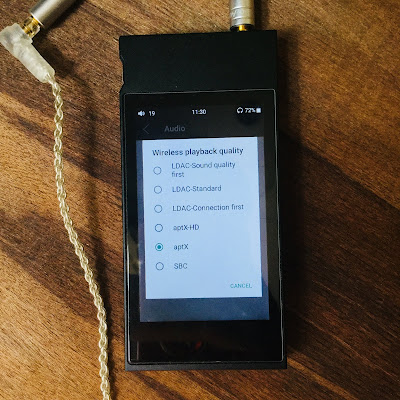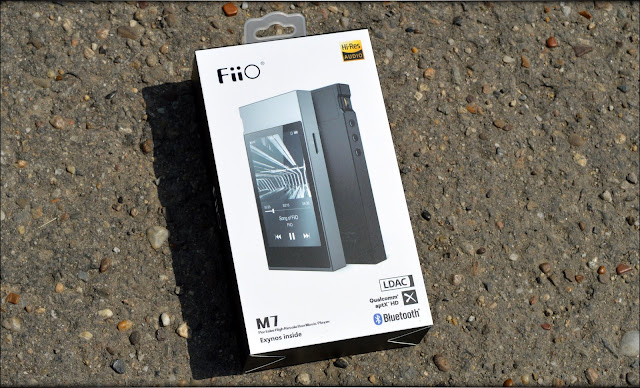FiiO M7 Review
- Expatinjapan

FiiO M7 review
- expatinjapan
http://www.fiio.net/en/products/89

FiiO M7 and FiiO FB1 Bluetooth earphones
A pleasing dap that at a generous asking price of US$200 delivers a wide range of options within its UI, plus Bluetooth and line out to boot, an expandable memory of 512GB via Micro SD slot, light weight and a beautiful screen.
The FiiO M7 is a pure player minus many of the bells and whistles that the audio community has come to expect. It is suitable for the budding audiophile, sporty type or person on the go.
The FiiO M7 has a natural, smooth delicate sound that is fairly balanced, approaches neutrality with a wee touch of warm depth at its nether reaches. It has enough clarity, transparency, speed, resolution to satisfy even the serious audiophile.
Unboxing





Clear case and USB C cable








Micro SD card slot, up to 512GB. More than enough.

Nice rotary volume wheel, physical buttons.
 Size!
Size! FiiO M7 and FiiO X7ii




Booting up and initial guide menus





Price
US199 on Amazon USA store.
 Specifications
Specifications
Main Unit
Name / Model No. M7 Operating System Deeply customized Android
CPU model Exynos 7270 14nm No. of cores 4
CPU operating frequency 1.4GHz DAC ES9018Q2C
Keyboard Virtual QWERTY keyboard Input method Touchscreen
Special features LDAC,FM radio,clock,gestures operation User interface Deeply customized /FiiO Music
Chips used SoC: Samsung Exynos 7270 , DAC:ES9018Q2C, FM chip:Si4705,Bluetooth chip:SAMSUNG S5N5C10B01-6330
Connectivity
WiFi N/A Bluetooth Bluetooth V4.2,aptX/aptX-HD supported
USB TYPE C USB2.0 LDAC Supported
Display screen
Display size 3.2 inches Number of colours 0.26 million colors
Display type TFT Viewable angle Full-view
Resolution 480×800 Pixel density 292 ppi
Touchscreen Yes
Storage
RAM 768MB Total ROM 4GB
Storage expansion type Micro SD card ROM available to user 2GB
Maximum storage expansion 512GB (only one micro SD card slot)
Buttons and ports
Buttons Side buttons + side volume wheel+ touchscreen Custom key mapping N/A
Headphone out 3.5mm standard headphone output jack (shared PO/LO) Balanced output N/A
Line out 3.5mm standard headphone output jack (shared PO/LO) USB connection TYPE C USB2.0(charging / data transfer)
Digital Coaxial/Optical out N/A
General
Color Black / Silver / Red / Blue Dimensions 52mm×109mm×13mm
Weight About 116 g Volume control 60 steps digital potentiometer
Recommended headphone impedance 16~100 Ω Equalizer 10-band EQ (±6dB), 9 presets+custom preset
Treble boost N/A Bass boost N/A
Balance control ±5 dB Gain control N/A
USB DAC N/A
Power specifications
USB power adapter DC 5V/2A recommended Battery Internal 1880mAh Li-polymer battery
Charging indication Red light indicates,blue light turns on after fully charged Charging time <2.5 h(DC5V/2A)
Battery indication Yes (accurate battery % readings)
Battery Life & Test Conditions
3.5mm headphone output:≥20 h
Volume 15 Load M3 open earbuds (27 Ω)
EQ OFF Screen OFF
Test File MP3 44.1kHz/16bit
Bluetooth output:>26 h
Volume 60 Load 32Ω
Test File MP3 44.1kHz/16bit Screen OFF
Others
Firmware Upgrade
Supported via zip file placed in internal storage or micro SD card
(*The product uses GPLv2 compliant firmware.)
Font size N/A
Clock Supported Third-party apps support N/A
FM Index
Output power
>20mW(76MHz)
>30mW(108MHz)
SNR
>50dBA(76MHz)
>70dBA(108MHz)
THD+N
<0.3%(76MHz)
<0.1%(108MHz)
Frequency response 20Hz~4KHz(-3dB)
Covered region 76-108MHz
Line output specifications
THD+N <0.004% (1 kHz/10kΩ) SNR ≥117dB (A-weighted)
Frequency response 20Hz~90 kHz(-3dB) Noise floor <3 uV
Channel separation ≥100dB (1 kHz) Line level >1.2Vrms (10 kΩ/1 kHz)
Headphone out specifications (3.5mm headphone out jack)
Output power 1 ≥70mW(16Ω / THD+N<1%) Output impedance <2 Ω(32Ω loaded)
Output power 2 ≥40mW(32Ω /THD+N<1%) THD+N <0.004%
Frequency response 10Hz~90 kHz(-3dB) Peak output voltage 3.35 Vp-p
SNR ≥117dB (A-weighted) Noise floor <3 uV
File format support
Lossless:
DSD:DSD64(“.dsf”,“.dff”)
APE - FAST:192kHz/24bit(MAX.)
Apple Lossless:192kHz/24bit(MAX.)
AIFF:192kHz/24bit(MAX.)
FLAC:192kHz/24bit(MAX.)
WAV:192kHz/24bit(MAX.)
WMA LOSSLESS:96kHz/24bit(MAX.)
Lossy compression:
AAC、MP3、WMA、OGG...
 Firmware updates
http://www.fiio.net/en/supports/56
I am running the latest Firmware 1.03 as I finish up this review.
Firmware updates
http://www.fiio.net/en/supports/56
I am running the latest Firmware 1.03 as I finish up this review.
The following changes and improvements have been made to the FW1.0.3 compared to the FW1.0.2:
1. Added Replay Gain function;
2. Added support for DSD 128 tracks;
3. Added new function of controlling Q5 via Bluetooth;
4. Added new function of displaying the whole track list of the current directory when playing track through the File Management app;
5. Fixed issue where the Previous Track button might not work after using the screenshot function;
6. Fixed issue where the beginning of the DSD track was missing when using USB audio output;
7. Fixed issue where FiiO Music might exit abnormally with the operations: play Favorites list -> remove a track from Favorites -> add that track to another playlist;
8. Fixed issue where after switching the language, adding a track from a playlist to the Favorites list would not work correctly;
9. Fixed issue where the album art could not be displayed for some APE tracks;
10. Fixed issue where the keyboard would not popup automatically after entering Search function;
11. Miscellaneous improvements and bug fixes.
Menu

Basic stock screen.
FiiO Music, FM radio, File management, Gallery, Technical support (Firmware update info, FAQs, quick start guide), Settings.

Wallpapers can be chosen for lock screen or main screen

FiiO Player interface, basically the same as the FiiO X7ii.
Swipe to the left side for tracks easy access.

Additional options and shortcuts within the player screen

Available Bluetooth options. variety a must for many these days.




Delete Tracks, always useful.



 Sound
Sound
Full, energetic, yet additionally fairly, delicate and even in its presentation.
Gentle, smooth and soft with a slight warmth at the furtherest low end, but also clear and fast.
Fun and musical with the right earphones, neutral and transparent with more reference earphones.
Not overly analytical, although it does has enough detail, clarity and separation to please.
These all may seem like opposing forces to some, but think of it more as inclusive and able to contain and include these within one form. The ideal is to find a sense of neutralness and transparency and the M7 comes very close to that. Thus allowing the earphones used to demonstrate their tuning.
Whilst the resolution, separation and layering is more than decent, it of course is not as high performing as higher priced daps, that is to be expected. It does not detract however from the quality of the M7 music playback ability and it place in the FiiO universe of daps and dacs..
It does well, stripped down of some functions other daps in the FiiO line up have such as wifi and swappable Amp modules etc means the low price does not automatically place this dap strictly in its price point. The omitted extras means you get a bit more, for less...If you are looking for a pure player minus all the extra bells and whistles.
The FiiO M7 has a natural sound, fairly neutral with a clear transparency and a solid black background.
 Overall
Overall
The FiiO M7 is an easy to use, light weight entry level Dap that should prove pleasing to many a budding audiophile. From its responsive touchscreen and its physical buttons is makes it a winning purchase for the person on the go, sports person, gym goer or budding audiophile.
Able to handle a wide variety of codecs, has Bluetooth, USB out to be used as a source, decent battery life, expandable storage via Micro SD cards to 512GB and a decent dac chip the M7 is a no brainer for many of the above mentioned potential users.
No wifi so that means no streaming Tidal, Spotify, Spot the dog for all you screamers. Its a pure player. That also means you have to do a hands on computer to SD card for any firmware updates.
The volume pot has 60 steps so it is very easy to find the perfect volume setting, the wheel is smooth in its usage and the little clicks than resonate to ones fingertips are pleasing.
I had no problems using it with my Campfire Audio Andromedas, the M7 has a very black background.
As a couple of other companies have recently released daps that are half the size of the FiiO M7 some may be forgiven for thinking FiiO missed the boat on this one. But for many the size of the M7 is very human and more what they desire than a tiny dap. Each to their own. Perhaps FiiO has something new up their sleeve....?
I am running the latest Firmware 1.03 as I finish up this review. See a few sections above (Firmware updates) as such features such as replay gain have been added.
The FiiO M7, with its many UI options, Bluetooth, light weight is a pure music player with a natural, smooth and lovely balanced response with enough neutrality, transparency and resolution to please.
A brave new world dap, thats also Kickin it old school.

With the FiiO FB1 Bluetooth earphones and the FiiO BTR BT amp.

































































